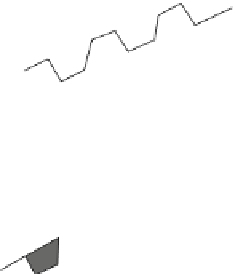Geoscience Reference
In-Depth Information
a
Horst & graben
Subducting plate
80 km/m.y.
Leading edge
Trench axis
Subduction erosion
b
0.2 km
5 km
Filled with slide deposits
Trench advance = 5 - 6 km/m.y.
c
Horst & graben
Trend of lineament
Subducting plate
8 cm/y to 300
o
Fig. 10
Model of trench advance to landward caused by landsliding. The graben structures are
filled by the collapse of the toe of the landward trench slope. In speed of the advance was calcu-
lated to be 5-6 km/m.y.
This first approximation is nearly equal to the value calculated by Lallemand
et al. (
1994
), supporting the idea that the landward slope toe collapses and fills the
grabens, and that the trend of the grabens imposes its orientation on the lineaments
of the landward slope.
5
Conclusions
1. The oceanward slope of the Japan trench is steep and characterized by horst and
graben structures caused by large-scale normal faulting due to downward bending
of the subducting Pacific plate.
2. The landward slope toe is also steep, and exhibits conspicuous submarine
landsliding. The lineaments on both the oceanward and landward slopes are













Search WWH ::

Custom Search